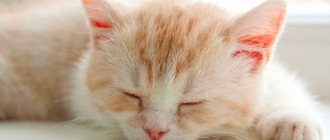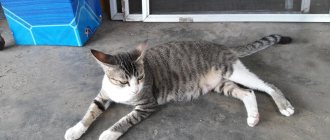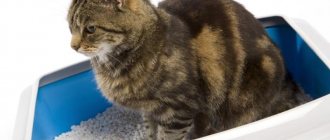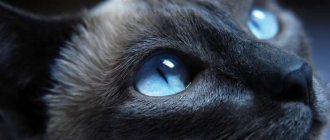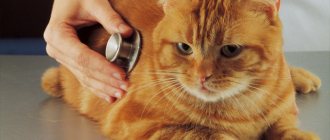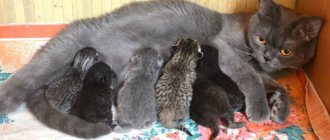Have you noticed changes in your pet? The eye is swollen, the cat often rubs its face, and tears flow from the corners? In this article, we will tell you what diseases and causes may cause ophthalmological problems in your pet, what you can do and what preventive measures will help you maintain your cat’s health.
The eyes are the main sensory organ through which cats perceive the outside world. Nature has endowed cats with acute vision (six times sharper than that of humans), and sometimes by looking into them, we can see the entire Universe.
This sense organ is not only the dignity and adornment of a beautiful animal, but also one of its weakest points. Very often, pets develop diseases that put the clarity and health of their vision at risk. It is important for every responsible owner to know what a pet’s healthy eyes look like and for what symptoms it is necessary to take it to the veterinarian.
Eye swelling in cats can signal a potential problem.
The cat's eye is swollen
Swelling of this organ is one of the main symptoms of most eye diseases. The main thing is not to ignore it, hoping that it is just temporary and everything will go away on its own. So, what to do?
What could be the consequences of ignoring this problem? For example, to loss of vision, which affects the behavior, activity and mood of your pet. Perhaps you think that everything is quite simple, the cat just hit its eye and you need to wait a couple of days? I hasten to inform you that swelling of the eye can signal more complex problems, ranging from internal pathologies to a malignant tumor. Treat this symptom with caution and do not neglect to consult a veterinarian
Causes of eye tumors in cats
Here is a list of diseases why such a symptom as swollen eyes appears in a cat:
- Trauma or bruise
- Foreign body
- Entropion (etripon)
- Conjunctivitis
- Keratitis
- Eye damage by helminths
- Tumor
Each disease has additional symptoms that can indicate the nature of the problem and ways to solve it. We will talk about them below.
Pay attention to your pet's behavior - this will help you more accurately identify the problem.
Tearing in a cat is not dangerous
If you notice that your kitten is sneezing and his eyes are watery, but there are no signs of any illness, perhaps he just got something in his nose. Cats naturally produce tears in the following cases:
- The pet just woke up.
- Features of the breed. Constant lacrimation is common in Persian, British and Scottish breeds.
- Entropion of the eyelid, which is usually observed in hairless cats.
- Getting hair in the eyes.
In any case, you need to maintain eye hygiene. They need to be washed periodically, as accumulated dirt can cause infection.
Injury
If your cat is active, plays a lot, runs and jumps, then the eye may be swollen due to a bruise. And if your pet is very warlike, then most likely he could get damaged in a fight. In any case, you definitely won’t be able to find out on your own, because the cat won’t be able to tell you that it took part in the fight for territory. And cats don't bruise.
If your kitten is acting restless, or you notice swelling, redness or tears, then he is most likely damaged. Cold compresses can help in this case.
Feed your cat food rich in vitamin A, which speeds up the regeneration and restoration of the skin.
If the amount of tear secretions increases, then you should not delay visiting the veterinarian, since during a fight the cat could damage the cornea of the eye. Without timely treatment, your pet may lose the injured eye.
When should a pet be treated?
Sometimes a healthy cat will discharge fluid or even pus. This can occur after prolonged sleep, inappropriate food, or an allergy to household chemicals or perfumes. The eyes of a British cat often fester due to the structural features of the muzzle and the shortened tear duct. If the discharge of pus is sporadic and goes away after washing, then there is nothing to worry about. But you should consult a doctor if you notice the following symptoms:
- the cat is restless and rubs its eyes with its paws;
- the eye is red or cloudy;
- the animal refuses food and hides in a dark place;
- the cat has a fever or has started vomiting and diarrhea;
- pus flows heavily and the muzzle around the eyes is wet all the time;
- the animal's eyelids stick together and swell;
- Due to the constant flow of pus, fur on the face began to come out.
Foreign body
Cats are by nature inquisitive creatures, and exploration and exploration of new territory is the norm for them. Your pet could injure and get debris into its eye while exploring the neighbor's bushes, or even indoor plants.
If you notice that your kitten is blinking frequently, rubbing its eye with its paw, or there is swelling, redness and discharge, then you should do an initial examination. The swelling may be hot to the touch.
When you are convinced that there is a foreign object in the cat’s eye, think several times about whether you should remove it yourself? After all, one awkward move and you can damage your eye irrevocably. It is better to call a veterinarian at home and follow his further recommendations.
If you rarely brush your pet, its own hair can easily get into the eye and cause irritation of the cornea.
Types of ophthalmological diseases
A cat is an inquisitive creature, so keeping track of it is quite difficult. But still, a swollen eye is a consequence, the cause of which must be determined. Perhaps the animal is too active, during play or jumping it could have been injured, but you did not pay attention. Or maybe a new component has appeared in the diet in the form of a new fish or houseplant. A cold, infection or insect bite, the inflammatory process could be provoked by anything, because the eye is one of the most sensitive organs.
What type of eye diseases can your cat get? It could be:
- injury;
- allergy;
- foreign body;
- conjunctivitis;
- corneal ulcer;
- eversion of the eyelid;
- infection;
- glaucoma;
- cataract;
- tumor.
Injury
It is very easy for an animal to get injured in a domestic environment. It’s even easier to get injured by your own species or your pet companion. During mating games, a cat can strike a cat, and a teenage kitten, as a result of its curiosity, can receive moral instruction from the older generation. And now the eye is swollen. If the injury was inflicted in the presence of the owner and the swelling is an obvious bruise, then it is necessary to apply a cold compress to the swollen area.
However, you should carefully monitor the behavior of the swelling to see if sluggish lacrimation appears. After all, with a deep scratch, a corneal ulcer can develop. To speed up the healing process of an injury, it is recommended to feed the animal with vitamin A.
Allergy
A cat's eye tumor can appear as a result of an allergic reaction, which could arise from anything:
- insect bite (flea, wasp);
- food products (meat, eggs, milk, fish, chocolate);
- indoor plants (monstera, ivy, dieffenbachia, stapelia).
It is necessary to wash the swollen eye with an antibacterial agent or furatsilin solution, also exclude protein from the diet, replacing it with special dry food and enrich the body with vitamins.
Foreign body
When you discover an eye tumor in your cat, examine the eye thoroughly. Perhaps a foreign body has gotten into it, be it an insect, sawdust, splinter or shavings, whatever. If you are confident that you can help the animal yourself, then you will need:
- sterile tweezers;
- cotton swab;
- furatsilin solution or warm water.
When removing a foreign body, you should be extremely careful not to get into the animal's eye and deprive it of its vision. If the risk is too great, then immediately show the cat to a veterinarian. Help from a professional will be much more effective.
Conjunctivitis
If your cat's swollen eye produces yellowish mucus, also known as pus, the area around the pupil is covered with blood capillaries, and the animal itself hides from the light, it is most likely conjunctivitis. Conjunctivitis can develop in a cat due to spring primrose pollen, a cold, or as a symptom of another, more serious disease. Conjunctivitis is an infectious disease, so it is necessary to protect the animal as much as possible from human sleeping places and places of personal hygiene. Before your cat is examined by a doctor, use clean cotton swabs to rinse the eye with one of the following solutions:
- A weak solution of potassium permanganate (pale pink color);
- A weak solution of boric acid;
- Brewed strong black tea;
- Chamomile decoction.
You can purchase eye drops at a veterinary pharmacy and apply them to sore eyes according to the instructions. If improvements do not occur, you should urgently show the animal to a veterinarian. Advanced conjunctivitis can lead to complications, resulting in the development of keratitis. Keratitis is a disease of the cornea of the eye, characterized by clouding of the transparent layer of the cornea; when neglected, ulcers and abscesses form. With timely treatment, you can save your cat’s vision and return her to her usual cheerful state.
Eversion of the century
An inversion or inversion of a cat's eyelid can occur as a result of injury or burns. If the eyelid turns inward, the hairs can irritate the cornea and cause tearing. Or the eyelid is turned in the opposite direction, then tears will roll down to the corner of the eye, which can turn into chronic conjunctivitis.
Eversion or inversion of the eyelids usually goes away after the inflammatory process subsides. Frequent eye rinsing and eye drops will help in the same way as treating conjunctivitis. But if the disease is prolonged, surgical intervention will be required. The skin on the eyelid is trimmed, sutures are placed on the incisions, and the eyelid itself is manually turned in the required direction.
Infection
Inflammation and tearing of the eyes are often symptoms of serious infectious diseases. First of all, protect the animal from children and personal hygiene products, since the disease can be contagious even to humans. If your cat has severe conjunctivitis that cannot be cured for a long time, immediately contact a veterinary clinic, because a serious disease is progressing in your pet’s body, for example:
- infectious rhinotracheitis (viral runny nose);
- calicivirus (a viral disease that affects the respiratory system);
- salmonellosis (infectious intestinal disease);
- chlamydia (a contagious disease that affects all reproductive and respiratory organs).
All infectious diseases require strict medical supervision, treatment with antibiotics and immune drugs.
Glaucoma
If, when examining a swollen eye, you notice that the eyeball is significantly larger than that of a healthy eye, and the pupil is abnormally dilated, then your pet has glaucoma. Glaucoma is increased eye pressure and can be treated with special drops and ointments.
Cataract
A symptom of cataracts is a cloudy pupil, so carefully examine your cat's eye under the swelling. There may even be a white coating on the lens, so sound the alarm, your pet is losing his sight. Older animals usually develop cataracts. It is almost impossible to cure it with medications, so surgery will be required.
Tumor
Unfortunately, even cats are not immune from developing tumors. If the swelling is located above or below the eye, the skin in this place is significantly different in color, the tumor feels quite dense to the touch, and the temperature is high, immediately contact a veterinary clinic. A biopsy will show whether the tumor is malignant or benign, and the doctor will prescribe further treatment or surgical removal.
Entropion (etropion)
This is a pathological condition in which the upper or lower eyelid turns towards the eyeball. This disease can be influenced by various factors: hereditary, acquired or age-related.
There are cat breeds in which the occurrence of entropion is increased (Persian, Maine Coon, Siamese, Sphynx, Scottish, British). This is due to the fact that the ligaments on the inside of the eye are weakened, and with age and decreased immunity, they become even more flabby and the eyes are attacked by viruses and bacteria, which leads to the occurrence of etropion.
In fact, all cats in old age (over 10 years old) are susceptible to this disease, and it can develop in both eyes and affect both the upper and lower eyelids.
Acquired factors include: injuries to the eyeball and other eye diseases (viral, infectious, fungal, neoplasms).
At the initial stage, the symptoms of volvulus can be confused with conjunctivitis: there is a fear of light, frequent blinking, and slight lacrimation. Further, the symptoms worsen: the eyelids swell, become red, the discharge becomes cloudy and increases in size. The Cat loses its appetite and interest in what is happening. With all the symptoms, it is important to know that the animal is feeling increasing pain.
The most important thing here is not to treat your pet’s eyes yourself, but to take them to a veterinary clinic for diagnostics. After all, the eyes are a very sensitive organ; we cannot know for sure that we will not harm the pet with our desire to help right now.
What treatment does the doctor prescribe?
After carrying out the necessary tests, the veterinarian prescribes medications that will cure exactly the disease that caused the suppuration. For example, without eliminating the cause of the allergic reaction, it is useless to wash the cat’s eyes and drip them; pus will still appear. And if suppuration is caused by toxoplasmosis or chlamydia, antibiotic therapy is necessary.
For local treatment, the following drugs are most often prescribed: “Bars”, “Iris”, “Mizofen”, “Neoconjunctivet” or “Anandin”. You can also rinse your eyes from pus with special solutions purchased at a veterinary pharmacy. It is best to use Lakrimin or Medkinos.
Conjunctivitis
As a rule, this disease is rarely registered as an independent disease. Most often, this is a signal of the presence of other problems: mechanical injuries, infectious diseases, parasitic worms in the eyeball, eyelash growth inside the eyelid (trochiasis), and even incorrectly selected dry food.
Symptoms of conjunctivitis:
- Photophobia;
- Swelling and redness;
- Frequent washing of the face;
- Decreased appetite;
- Discharge (which increases and the eye sticks together).
Reference
In almost 60% of cases of conjunctivitis infection, symptoms appear in only one eye, and after a few days the second eye is involved in the process.
When the first symptoms are detected, to alleviate the condition, you need to provide the animal with rest in a room with dim light, and also rinse the eyes with an antiseptic solution. Next, contact a veterinarian to make a correct diagnosis, conduct diagnostics and prescribe treatment.
There is also a risk for humans of contracting conjunctivitis from a cat.
Recommended clinics
If you find lumps on your cat’s belly, you should contact a clinic that immediately has a surgeon, oncologist and dermatologist to quickly determine the cause and further treatment.
Moscow
- Veterinary clinic White Fang. There is a branch in Kaliningrad. They work around the clock. There is an MRI machine. There is an oncology department.
- Network of veterinary clinics Medvet. Vilkovysky I.F. - chief physician, head of the surgical department, leading surgeon. Candidate of Veterinary Sciences.
- Veterinary center Komondor. Wide range of veterinary services. There is an animal rehabilitation unit. The clinic’s doctors are active participants in veterinary conferences and symposiums.
Saint Petersburg
- Vetus veterinary clinic network. Oncologist Tamoshkin D.A. – chief physician, lecturer at St. Petersburg veterinary surgical conferences.
- Pride Cancer Center. MRI available. Chief physician Bryushkovsky K.Yu. He is a candidate of veterinary sciences and teaches at the St. Petersburg State Academy of Veterinary Medicine.
Murmansk
- Animal care. The clinic has been operating since 2006. Chief physician Ivaneeva O.E. - a general specialist.
- Clinic Ivetas. The first clinic in Murmansk with equipment for endoscopic operations and other types of research.
- Veterinary clinic Favorit. Conducts a wide range of diagnostic and therapeutic procedures. Cooperation has been developed with the Clinic of Neurology and Intensive Care of Dr. V.V. Sotnikov, St. Petersburg, and the White Fang Clinic, Moscow.
Read other articles about cats on the Guardian of Purity portal. Stay with us!
Keratitis in cats
Another one of the most common ophthalmological diseases in cats. Keratitis is an inflammation of the cornea. You can recognize it immediately by a clouded eye.
This disease can also occur due to other reasons: foreign body, conjunctivitis, eye burns (difficult to treat), allergies, infection, vitamin deficiency, inflammation of the lacrimal glands, genetic predisposition (most often artificially bred cats are prone to this disease - Siamese, Persians, British).
In addition to clouding of the cornea, you need to pay attention to a number of symptoms that will confirm your fears:
- Manifestation of blood vessels;
- Severe photophobia;
- Fluid accumulation inside the eye;
- The appearance of scars (indicates that the disease is at the last stage and further treatment will most likely not bring any results).
As you probably already understood, independent treatment is contraindicated, and first you need to find out the causes of keratitis. You can examine the eye for the presence of foreign bodies, assess the general condition, but only a qualified veterinarian can determine the severity of the disease and prescribe treatment.
Cloudiness of the eyeball indicates the possibility of more complex internal diseases.
Detailed description of common causes
If a cat has a swollen upper eyelid, then first of all the possibility of congenital pathologies associated with abnormal eyelash growth is excluded. If there is swelling in the lower eyelid and there are signs of inflammation, then consider options with blepharitis, which can be caused by a bacterial or fungal infection. But, before making a diagnosis, it is imperative to exclude the following possible causes of this symptom:
Blepharitis. An inflammatory process caused by injury, an allergic reaction or bacterial infection. With blepharitis, a cat's eyelids almost always become swollen and there is discomfort caused by excessive tearing due to stuck together eyelashes. In many cases it occurs together with conjunctivitis. Blepharitis is not considered an independent disease; its appearance is always provoked by something, so symptomatic treatment is ineffective. This is especially true for cases associated with congenital pathologies (third eyelid prolapse). Once the cause is eliminated, swelling and redness almost always subside. As a preventive measure, eye drops with anti-inflammatory and antibacterial effects can be prescribed.- Foreign body. Plant seeds, weed thorns or cactus needles can also become embedded in the mucous membrane of the eyelid. Therefore, if a cat has a swollen eyelid, then the option of a splinter should be ruled out first. The danger of foreign bodies is that they can injure the cornea during blinking. This can lead to the development of uveitis and keratitis. In many cases, owners manage to get splinters out on their own without the help of a veterinarian. But, to eliminate the possibility of infection, all instruments (usually tweezers are used) must be thoroughly treated with an antiseptic solution. After this, you can use antibacterial and anti-inflammatory drops for 2-4 days. In difficult cases, surgical intervention is required. If you ignore the problem, then everything can end with purulent conjunctivitis and keratitis, due to which the pet’s quality of vision may decrease.
Injury. Most often, damage to cats occurs after street fights. In pets, such injuries occur after active games or falls from a height. Therefore, if a cat’s eyelid is swollen after a blow, then you should consider the option of a hematoma or bruise, which most often goes away on its own within a few days. During this period, much attention is paid to the eye itself. At the slightest suspicion of purulent discharge or souring of the eyes, it is recommended to immediately contact a veterinarian.- Abnormal eyelash growth. This is when one or more eyelashes grow incorrectly from birth, thereby injuring the cornea. Because of this, an inflammatory process begins, which results in redness and swelling of the eyelid, cornea and white of the eye. Associated symptoms include increased lacrimation and purulent discharge from the eyes. If the problem is neglected, the development of uveitis and deep keratitis cannot be avoided. The best solution to the problem of double rows or abnormally growing eyelashes is hair removal.
- Turning of the eyelids. Most often found in decorative breeds (Maine Coon, exotics, Scots, British). In Persians, this defect is considered congenital, so it manifests itself already in the first months of life. This manifests itself in the fact that the eyelid turns inward, thereby irritating and injuring the cornea. At the initial stage, the problem will manifest itself in slight swelling and redness of the eyelids, lacrimation. If the issue is not resolved at this stage, then there is a high probability that complications will appear in the form of clouding of the cornea and purulent discharge from the eye. Conservative methods, unfortunately, are ineffective, so the best option is considered to be surgical intervention, during which an incision is made and excision of eyelid flaps. After suturing, nothing else touches the cornea. Complete healing will take 2 to 4 weeks.
In kittens aged 2 to 6 months, the eyelid may become swollen due to respiratory viral infections. But complications affect both organs of vision at once. In case of a single lesion, the option of trauma and congenital pathologies of the eyelid is considered (especially in Persian cats).
Eye damage by helminths
It is believed that worms in the eyes of a cat is a myth, but you should know that theoretically these parasites can live in any organ. It is important to remember that helminths of this type are very dangerous and your pet may simply lose his sight if treatment is not started in time.
How do these parasites get into a cat's eyes? They require an intermediate carrier – fruit flies. They sit on the animal’s eyelids, lay eggs close to the mucous membrane, and when the pet washes itself, they inseminate it. After the development stage, the egg develops into a larva, which moves into the eyeball and begins to grow.
Symptoms that indicate that the eye is affected by helminths:
- Loss of eyelashes;
- Itching in the eye area;
- lacrimation;
- Inflammation of the mucous membrane and cornea
- Cloudiness
- Increased body temperature
- Deterioration of vision (blindness)
This symptomatology is well known to us and is very similar to other ophthalmological diseases that we have already listed. A definitive diagnosis can only be made in a clinical setting.
Eye diseases of cats
Diseases affecting the eyelids of an animal include:
- Inflammation of the eyelid (blepharitis).
- Wounds and bruises.
- Entropion or inversion of the eyelid.
- Ptosis (drooping of the upper eyelids).
- Lagophthalmos (fusion) of the eyelids.
- Neoplasms.
affect the eyeball :
- Conjunctivitis.
- Glaucoma (high blood pressure).
- Cataract.
- Dermoid (neoplasm in the conjunctiva).
- Dislocation of the eyeball.
- Corneal ulcers and inflammation.
- Keratitis.
Tumor
All of the previously listed diseases are, for the most part, treatable if the causes are identified in time. But there is a disease in which swelling in the eye area may indicate the presence of a neoplasm. If, in addition to the tumor, your pet begins to have difficulty oriented in space, or there is a noticeable disturbance in the coordination of movements, then conduct an independent examination.
If the swelling is hard and there is an increase in body temperature, this is a reason to sound the alarm and immediately take the animal to a veterinary clinic, this will increase the chances of a positive outcome and possible avoidance of surgical intervention.
If, during a self-examination, you notice that the swelling has a dense structure, then the best solution is to contact a veterinary clinic.
Causes
Veterinary experts distinguish 2 main categories of causes of eye diseases:
- Disturbances in the functioning of protective organs and the eyeball itself. These include various injuries and burns, inversions and eversion of the eyelids, fusion and drooping of the eyelids, eye loss, blepharitis, neoplasms;
- Pathology of the organ of vision itself. These are: glaucoma, cataracts, conjunctivitis, keratitis, iritis, panophthalmitis, uveitis, etc.
All of them require urgent veterinary care, as they can become chronic, which is either very difficult to treat or incurable, and the organ will have to be removed.
Treatment of eye tumors
During the examination, the doctor will take the necessary tests from the animal; in case of swelling of the eye, an urgent biopsy will most likely be required. The results will show whether the tumor is benign or malignant.
Treatment of cancer in cats requires a comprehensive approach and depends on the degree of development of the disease. Therapy consists of surgery, radiation and chemotherapy. The choice of treatment depends on the type of cancer cells, the location of the cancer, and the presence of metastases. To treat cancer in pets, surgery is often used.
But surgery is not always the way to recover a pet. Sometimes a veterinarian may prescribe radiation or chemotherapy to stop the progression of the disease or to exclude possible relapses.
Apathy, disorientation, and lack of appetite may indicate the presence of cancer.
Prevention of eye diseases
To prevent your pet from having eye problems, it is important to take some measures to prevent ophthalmic diseases:
- If your animal goes outside, then inspect the eyes daily for the presence of foreign bodies and the absence of injuries;
- The house should be clean to avoid allergic reactions and also debris;
- Brush your pet more often, because when washing, hair can also get into the mucous membrane of your pet’s eyes;
- Vaccination is very important, because thanks to it the cat has a strong immune system and is less susceptible to infectious diseases;
- Monitor your pet’s diet so that it receives a sufficient amount of vitamins through food;
- Mandatory deworming every 4-6 months.
Regarding cancer, there are no methods of prevention. Not a single animal is safe from it. Cats die from cancer just like other pets, dogs. It has been proven that various factors provoke cancer, one of them is chronic diseases, which can be avoided by applying preventive measures.
Preventative measures will help avoid further illnesses in your pet.

